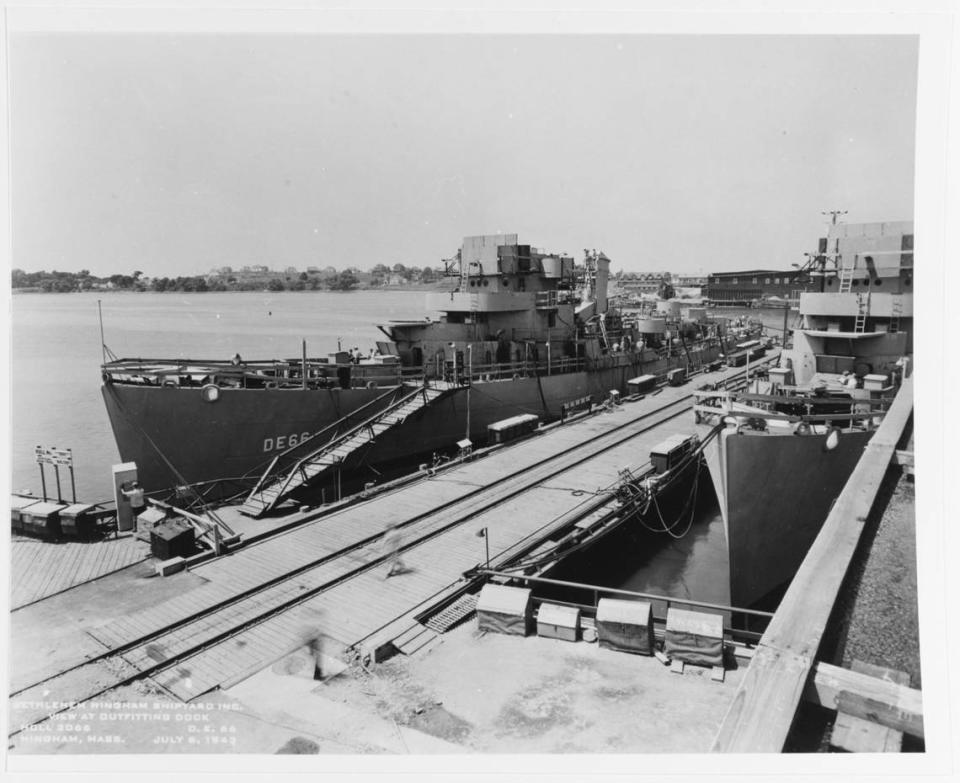The USS Amesbury, a well-documented hazardous shipwreck off South Florida, has a mysterious log that details its travels during World War II. This log was found in Massachusetts, stuck in a piece of furniture, raising questions about who wrote it, what happened to the author, and how it ended up so far from the shipwreck. The content of the notebook intrigues maritime archaeologist Matthew Lawrence, providing insight into someone’s experience with the USS Amesbury. One of the entries dated April 7, 1945, simply states, “War ended with Germany,” which predates Hitler’s suicide and Germany’s surrender.
The USS Amesbury served as a naval destroyer from 1943 until the end of World War II, playing a role in the invasion of Normandy by attacking German planes. Decommissioned by the Navy in July 1946, the ship was eventually placed in reserve. The travel log reveals that the ship spent two months off Key West in 1944, surviving a hurricane during that time. The USS Amesbury now rests 5 miles west of Key West, where it sank and was intentionally sunk to create a deep water artificial reef. Known locally as Alexander’s Wreck, the ship lies in 25 feet of water with visible deck guns, making it part of the Florida Keys National Marine Sanctuary’s Shipwreck Trail.
Maritime archaeologist Matthew Lawrence believes the notebook found in Massachusetts was likely someone’s personal observations rather than an official log for the ship. The notebook was discovered by Brenda O’Keefe of Massachusetts, who then contacted the sanctuary to share her find. Since the Florida Keys Sanctuary does not have a suitable archive for the notebook, Lawrence suggested contacting other naval archives better equipped for its preservation. The journal remains in O’Keefe’s possession while the mystery of its origins and the author’s identity continue to puzzle historians.
The USS Amesbury’s history as a naval destroyer during World War II shines a light on the experiences of those who served on the ship. The discovery of the travel log in Massachusetts adds a new layer of intrigue to the ship’s story, offering a personal glimpse into its past and raising questions about its journey. As a part of the Florida Keys National Marine Sanctuary’s Shipwreck Trail, the wreck of the USS Amesbury remains a reminder of its service and sacrifice during the war. The notebook’s content, including the enigmatic entry about Germany’s surrender, adds to the shipwreck’s mystique and invites further exploration into its fascinating history.
The fate of the USS Amesbury, from its commissioning in 1943 to its sinking off Key West, reveals a vessel that played a significant role in World War II and later became an artificial reef for marine life. The ship’s final resting place, split in two off the coast of South Florida, serves as a reminder of its service and the lives it touched during the war. Through the discovery of the travel log in Massachusetts, new insights into the USS Amesbury’s past have come to light, sparking curiosity and a desire to uncover more about its history. The journal’s journey from wartime naval vessel to artifact found in a piece of furniture is a testament to the enduring legacy of the USS Amesbury and those who served aboard it.
The mix of official records, personal observations, and maritime history surrounding the USS Amesbury creates a rich tapestry of stories waiting to be told. From the ship’s involvement in major battles to its transformation into an artificial reef, the Amesbury’s legacy lives on through historical records and physical remains. The discovery of the travel log in Massachusetts adds a personal touch to the ship’s history, offering a glimpse into the daily lives and experiences of those who served on board. As researchers continue to piece together the puzzle of the USS Amesbury’s past, new revelations and insights are sure to emerge, shedding light on a little-known chapter of World War II naval history.















